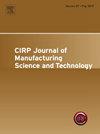Mechanochemical effect-assisted ultrasonic grinding of functional microgrooves on zirconia denture surface
IF 5.4
2区 工程技术
Q2 ENGINEERING, MANUFACTURING
CIRP Journal of Manufacturing Science and Technology
Pub Date : 2025-06-02
DOI:10.1016/j.cirpj.2025.05.008
引用次数: 0
Abstract
Inspired by natural teeth, texturing groove-type microstructures on zirconia implant dentures is an efficient approach to enhance their tribological and antibacterial performances. However, the current surface texturing methods for zirconia ceramic dentures, primarily laser ablation or grinding, often induce severe surface damage due to their high hardness. In this study, a coating-assisted rotary ultrasonic grinding (CUG) process is proposed to fabricate microgrooves on zirconia ceramic. This method aims to improve surface quality by leveraging the local embrittlement caused by the mechanochemical effects of the coating and ultrasonic vibration. A series of surface texturing, grinding, and nanoindentation tests are conducted to evaluate the process performance and underlying mechanism of the CUG. The results demonstrate that compared to conventional grinding (CG), CUG can reduce the surface roughness of the microgrooves by an average of 73.4 % and decrease the cutting force by an average of 72.7 %. The process mechanism of CUG can be attributed to the synergistic effects between the surface coating and ultrasonic grinding, both causing local embrittlement of zirconia ceramics, increasing small local cracks, and reducing larger macro defects. Additionally, the effects of microgrooves on surface performance, including wettability, tribological behavior, and bacteria adhesion, are assessed. Compared to a smooth surface, the CUG textured surface exhibits excellent hydrophobic properties, the friction coefficient reduced by 50.6 %, and an increase in the bacteriostatic rate by 74.7 %.
机械化学效应辅助下氧化锆义齿表面功能微槽的超声磨削
受天然牙齿的启发,在氧化锆种植义齿上织构凹槽型微结构是提高其摩擦学和抗菌性能的有效方法。然而,目前氧化锆陶瓷义齿的表面织构方法主要是激光烧蚀或磨削,由于其硬度高,往往会导致严重的表面损伤。在本研究中,提出了一种涂层辅助旋转超声磨削(CUG)工艺在氧化锆陶瓷上制备微沟槽。该方法旨在通过利用涂层的机械化学效应和超声波振动引起的局部脆化来改善表面质量。通过一系列的表面织构、磨削和纳米压痕试验来评估CUG的工艺性能和潜在机理。结果表明,与常规磨削(CG)相比,CUG磨削可使微槽表面粗糙度平均降低73.4%,切削力平均降低72.7%。CUG的过程机理可以归结为表面涂层与超声磨削的协同作用,两者都能引起氧化锆陶瓷的局部脆化,增加局部小裂纹,减少较大的宏观缺陷。此外,还评估了微槽对表面性能的影响,包括润湿性、摩擦学行为和细菌粘附性。与光滑表面相比,CUG织构表面具有优异的疏水性,摩擦系数降低了50.6%,抑菌率提高了74.7%。
本文章由计算机程序翻译,如有差异,请以英文原文为准。
求助全文
约1分钟内获得全文
求助全文
来源期刊

CIRP Journal of Manufacturing Science and Technology
Engineering-Industrial and Manufacturing Engineering
CiteScore
9.10
自引率
6.20%
发文量
166
审稿时长
63 days
期刊介绍:
The CIRP Journal of Manufacturing Science and Technology (CIRP-JMST) publishes fundamental papers on manufacturing processes, production equipment and automation, product design, manufacturing systems and production organisations up to the level of the production networks, including all the related technical, human and economic factors. Preference is given to contributions describing research results whose feasibility has been demonstrated either in a laboratory or in the industrial praxis. Case studies and review papers on specific issues in manufacturing science and technology are equally encouraged.
 求助内容:
求助内容: 应助结果提醒方式:
应助结果提醒方式:


